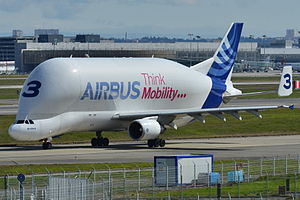Airbus Beluga
| A300-600ST Beluga | |
|---|---|
 |
|
| Beluga in the Airbus livery | |
| Role | Outsize cargo freight aircraft |
| Manufacturer | Airbus |
| First flight | 13 September 1994 |
| Introduction | September 1995 |
| Status | In service |
| Primary user | Airbus Transport International |
| Produced | 1992–c.1999 |
| Number built | 5 |
| Unit cost |
$285 million
|
| Developed from | Airbus A300-600 |
| Airbus Beluga diagrams | |
|
|
The Airbus A300-600ST (Super Transporter) or Beluga, is a version of the standard A300-600 wide-body airliner modified to carry aircraft parts and oversized cargo. It received the official name of Super Transporter early on; however, the name Beluga, a large whale, gained popularity and has since been officially adopted. The Beluga XL, based on the Airbus A330 with similar modifications and dimensions, is being developed by Airbus to replace the type around 2020.
Several major aircraft manufacturers are multinational, and it is not unusual for them to have plants in widely separated locations. Airbus is unique in that although it is today a standalone multinational corporation, it was originally a consortium formed by the major British, French, German, and Spanish aerospace companies. The geographic location of Airbus manufacturing is not only influenced by cost and convenience; it is also a matter of aviation history and national interest. Historically, each of the Airbus partners makes an entire aircraft section, which would then be transported to a central location for final assembly; even after the integration of Airbus into a single firm, the arrangement remained largely the same, with Airbus partners becoming subsidiaries or contractors of the multinational pan-European company. The details vary from one model to another, but the general arrangement is for the wings and landing gear to be made in the UK, the tail and doors in Spain, the fuselage in Germany, and the nose and centre-section in France, with final assembly in either Toulouse, France; Hamburg, Germany; or Seville, Spain.
When Airbus started in 1970, road vehicles were initially used for the movement of components and sections; however, growth in production volume soon necessitated a switch to air transport. From 1972 onwards, a fleet of four highly modified "Super Guppies" took over. These were former from the 1940s that had been converted with custom fuselages and the adoption of turbine engines to carry large volume loads for NASA's space program in the 1960s. Airbus' use of the Super Guppies led to the jest that "every Airbus is delivered on the wings of a Boeing". As time went on, the Super Guppies grew increasingly unsatisfactory for Airbus's ferrying needs: their age meant that operating expenses were high and ever-increasing, and growing Airbus production required greater capacity than could be provided by the existing fleet.
...
Wikipedia
